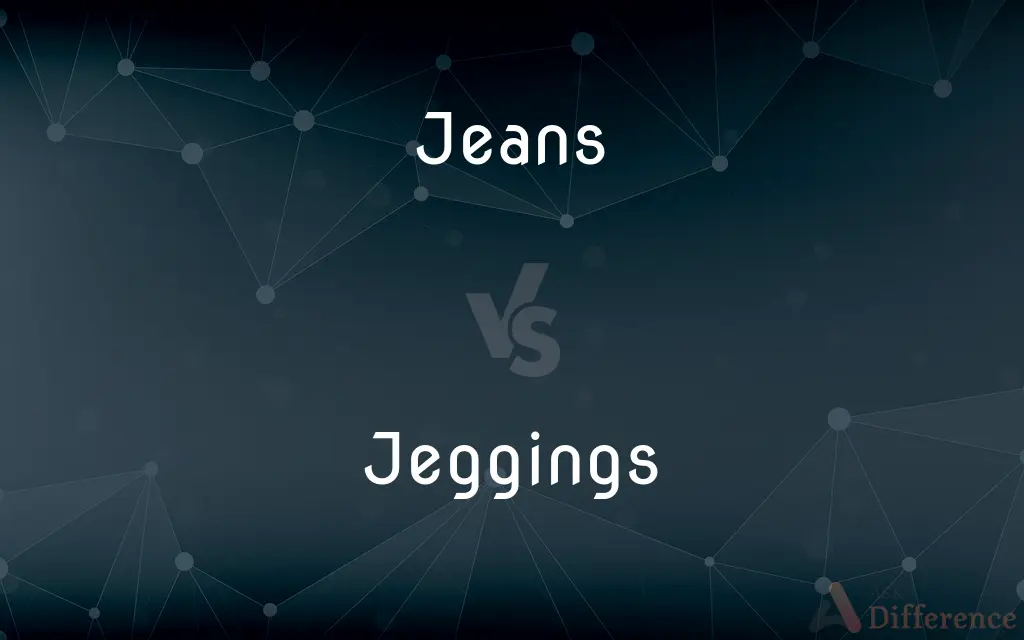Jeans vs. Jeggings — What's the Difference?
By Fiza Rafique & Urooj Arif — Updated on April 17, 2024
Jeans are traditionally made from denim fabric with a stiffer feel and structured fit, whereas jeggings are a blend of jeans and leggings, featuring stretchable material for a tight, form-fitting look.

Difference Between Jeans and Jeggings
Table of Contents
ADVERTISEMENT
Key Differences
Jeans are crafted from denim, a sturdy cotton twill fabric, giving them durability and a classic look, while jeggings are made primarily from a stretchy fabric like a blend of cotton and elastane, offering greater flexibility and comfort.
Jeans typically feature zipper flies and button closures, providing a traditional pants appearance, whereas jeggings often have an elastic waistband and may mimic the look of jeans with faux zippers and pockets.
The cut of jeans can vary widely from skinny to wide-leg styles, catering to different fashion tastes and body types, whereas jeggings generally maintain a very slim silhouette, closely resembling skinny jeans.
Jeans are suited for a wide range of activities and environments due to their robust material, on the other hand, jeggings, with their lightweight and stretchy fabric, are often preferred for casual wear or more active scenarios where movement is a priority.
Denim jeans offer a timeless aesthetic that can be dressed up or down, whereas jeggings provide a modern, sleek look that aligns more with casual and comfort-driven attire.
ADVERTISEMENT
Comparison Chart
Material
Denim (cotton twill)
Stretch fabric (cotton and elastane)
Closure
Zipper fly and button
Elastic waistband
Fit
Varies (skinny, straight, wide-leg)
Primarily skinny
Pockets
True pockets
Often faux or no pockets
Typical Usage
Versatile, casual to semi-formal
Casual, comfort-focused
Compare with Definitions
Jeans
A pair of pants made from denim, known for their durability.
He wore his favorite jeans to the concert.
Jeggings
Jeggings often incorporate an elastic waistband for added comfort.
Her jeggings had a high-rise elastic waistband that was both comfortable and flattering.
Jeans
Jeans are available in various fits such as skinny, bootcut, and straight-leg.
She prefers straight-leg jeans for their classic style.
Jeggings
Some jeggings feature decorative stitching to mimic jeans.
Her jeggings had faux pockets and stitching but were smoother than actual jeans.
Jeans
Jeans can be styled in numerous ways, making them a wardrobe staple.
He paired his jeans with a blazer for a smart-casual look.
Jeggings
Tight-fitting leggings designed to resemble jeans.
She wore jeggings for the yoga class because they were so stretchy.
Jeans
Historically, jeans were designed as workwear for laborers.
Jeans gained popularity as sturdy workwear that could withstand heavy use.
Jeggings
Jeggings provide a body-hugging fit, enhancing the silhouette.
Jeggings hugged her figure perfectly, complementing her tunic top.
Jeans
The color and wash of jeans can vary significantly.
She loves dark wash jeans for their slimming effect.
Jeggings
They are a popular choice for casual wear due to their sleek look.
Jeggings are perfect for a casual day out with friends.
Jeans
Jeans are a type of pants or trousers, typically made from denim or dungaree cloth. Often the term "jeans" refers to a particular style of trousers, called "blue jeans", which were invented by Jacob W. Davis in partnership with Levi Strauss & Co.
Jeggings
Jeggings () are leggings that are made to look like skin-tight denim jeans. The word is a portmanteau of the words jeans and leggings.
Jeans
Hard-wearing casual trousers made of denim or other cotton fabric
He wore a pair of faded jeans and a white T-shirt
Jeggings
Tight-fitting stretch trousers for women, styled to resemble a pair of denim jeans.
Jeans
A strong, twilled cotton, traditionally used in making uniforms and work clothes.
Jeggings
Denim leggings, or very skinny jeans.
Jeans
Jeans Pants made of jean, denim, or another durable fabric.
Jeans
A pair of trousers made from denim cotton.
Traditionally most jeans are dyed dark blue.
Jeans
Plural of jean
Common Curiosities
What are jeans made of?
Jeans are primarily made of denim, a durable cotton fabric.
What makes jeggings different from jeans?
Jeggings are made from a stretchy fabric and usually have an elastic waistband, unlike the sturdy denim and zippered closure of jeans.
Are jeggings comfortable for long wear?
Yes, due to their stretchy material, jeggings are often more comfortable for long periods of wear compared to traditional jeans.
How long do jeans typically last?
With proper care, jeans can last for several years due to their durable denim construction.
What are the best occasions to wear jeans?
Jeans are versatile and can be worn in casual, business casual, or semi-formal settings depending on the style and accessories.
What are the environmental impacts of producing jeans?
Jeans production, especially the use of water and chemicals in denim processing, can be environmentally intensive.
Are jeans suitable for all body types?
Yes, jeans come in various styles and cuts to suit different body types, from skinny to wide-leg options.
Can jeggings be worn for formal occasions?
Jeggings are generally considered too casual for formal settings, though they can be styled appropriately for smart-casual events.
Can jeggings replace jeans in a wardrobe?
Jeggings can complement jeans in a wardrobe, offering a more form-fitting, stretchy option for casual wear.
How do I choose between jeans and jeggings?
Choose jeans for durability and classic style, or jeggings for comfort and a tighter fit.
Are there eco-friendly options for jeans and jeggings?
Yes, both jeans and jeggings are available in eco-friendly options made from organic materials and sustainable production processes.
Do jeggings have real pockets?
Some jeggings have real pockets, but many have faux pockets or none at all to maintain a sleek silhouette.
Can jeans be altered to fit better?
Yes, jeans can be tailored for a better fit, adjusting the length or waist as needed.
How do I care for my jeans and jeggings?
Jeans usually require less frequent washing to preserve the fabric, whereas jeggings may need careful washing to maintain elasticity.
Why have jeggings become popular?
Jeggings have gained popularity due to their comfort and versatility, aligning with modern trends in casual and active wear.
Share Your Discovery

Previous Comparison
Monk vs. Friar
Next Comparison
Distributor vs. StockistAuthor Spotlight
Written by
Fiza RafiqueFiza Rafique is a skilled content writer at AskDifference.com, where she meticulously refines and enhances written pieces. Drawing from her vast editorial expertise, Fiza ensures clarity, accuracy, and precision in every article. Passionate about language, she continually seeks to elevate the quality of content for readers worldwide.
Co-written by
Urooj ArifUrooj is a skilled content writer at Ask Difference, known for her exceptional ability to simplify complex topics into engaging and informative content. With a passion for research and a flair for clear, concise writing, she consistently delivers articles that resonate with our diverse audience.














































